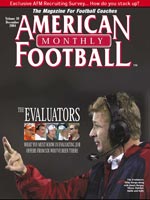AMERICAN FOOTBALL MONTHLY THE #1 RESOURCE FOR FOOTBALL COACHES
Article CategoriesAFM Magazine
|
Scorching the DefenseBlinn College\'s high powered offense continues to set recordsby: Patrick Finley © More from this issue >Scott Maxfield is confident, maybe even a little cocky. Running his no-huddle spread offense at Blinn College, he deserves to be. After leading the nation with 558.7 yards per game at the junior college level last season, you get the impression that Maxfield’s Buccaneers can move the ball at will. In fact, he’ll come close to telling you that himself. “It doesn’t matter to us what we see,” said Maxfield, the head coach and offensive coordinator. “If people want to play zone, we’ll drive the football. If they want to play man, we have an opportunity to see big plays.” “We’ve seen few people blitzing lately. That’s because ....The full article can only be seen by subscribers. Subscribe today!
|
|
|||||||
| HOME |
MAGAZINE |
SUBSCRIBE | ONLINE COLUMNISTS | COACHING VIDEOS |
Copyright 2025, AmericanFootballMonthly.com
All Rights Reserved





